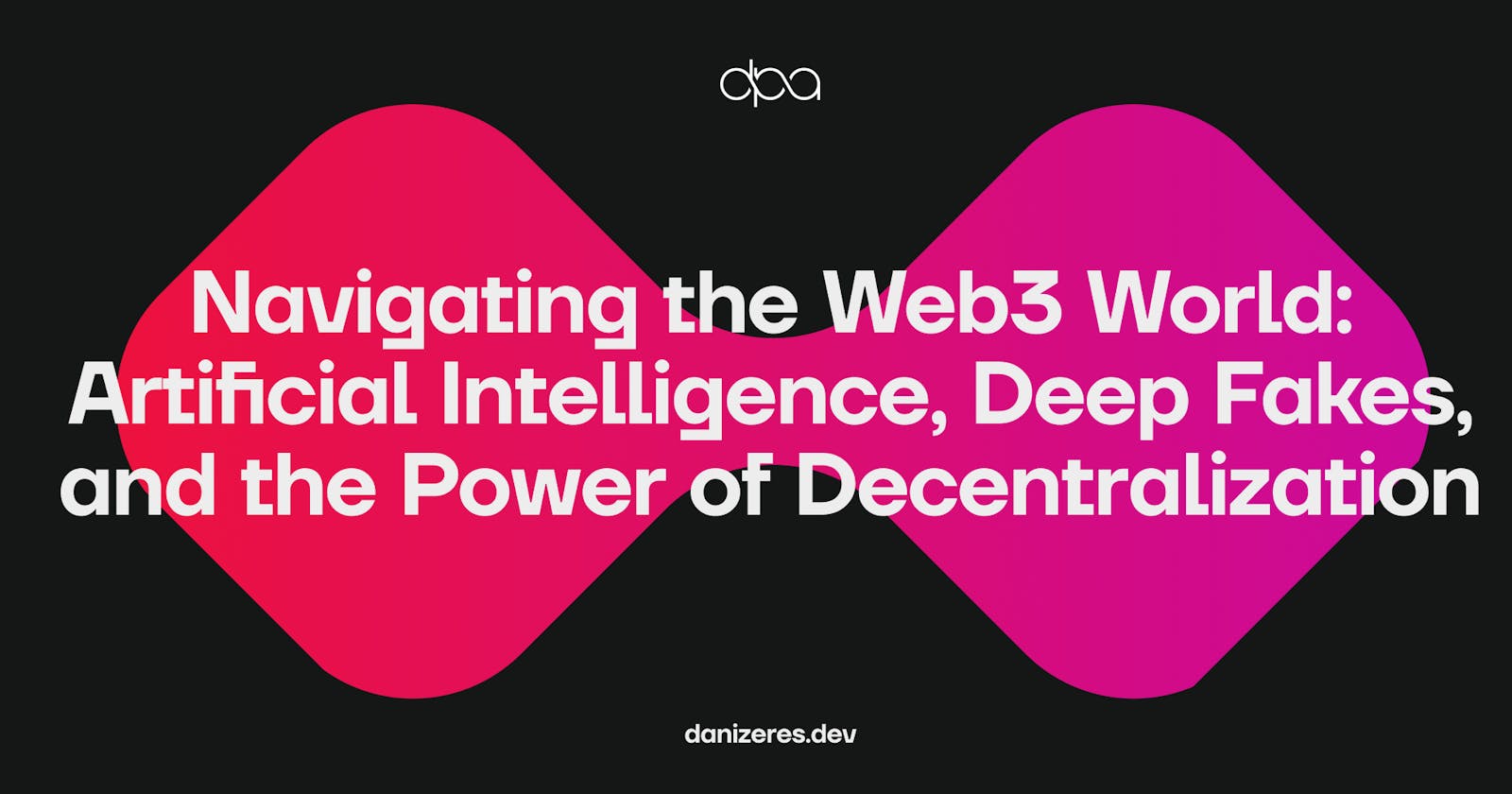Navigating the Web3 World: Artificial Intelligence, Deep Fakes, and the Power of Decentralization
The concerns regarding the trustworthiness and authenticity of digital content are more important than ever in our increasingly digital environment, where Artificial Intelligence (AI) is a vital component of our daily lives. Here, I'll discuss how web3's decentralized structure and verification tools can offer a potentially effective remedy, especially in light of the growing frequency of AI-generated deep fakes and their potential to affect our social and political structures.
The Rise of AI and Deep Fakes
Deep fakes are just one of a wide range of new applications made possible by AI's exponentially increasing capabilities in recent years. Deep fakes are artificial intelligence (AI) created images, movies, or voice recordings that appear to be the actual thing in some cases. They are able to produce fake media where characters appear to say or do things they have never done. This might take the form of lawful usage like face-swapping on social media filters or more nefarious ones like fabricating political speeches or using people's real names for fraudulent purposes.
Here's a simplified example of how a deepfake video can be created using AI:
from deepfake_generator import DeepFake
# Initialize a deepfake generator
deepfake = DeepFake()
# Load the source and target videos
source_video = deepfake.load_video('source_video.mp4')
target_video = deepfake.load_video('target_video.mp4')
# Create a deepfake video
deepfake_video = deepfake.create(source_video, target_video)
# Save the deepfake video
deepfake.save(deepfake_video, 'deepfake_video.mp4')
Keep in mind that the code above is super simple and sophisticated programming techniques, complicated neural networks, and computer resources are required to produce deep fakes in reality. More importantly, it raises serious ethical and perhaps legal issues.
Web3 and Decentralization
Web3, or the decentralized web, offers a creative approach to the problems brought on by AI and deep fakes. In sharp contrast to web2's centralized systems, Web3 seeks to build a more open and trustworthy internet by utilizing blockchain technology.
In order to store and handle data, traditional web applications (web2) rely on a central authority (such as a business or service provider). This raises issues with privacy and runs the risk of being controlled or manipulated.
In contrast, web3 uses a peer-to-peer (P2P) network design in which data and control are distributed among several nodes. This makes sure that no one organization can completely control the network. A blockchain network maintains a high level of data integrity and security since each node has a copy of the full blockchain and transactions are validated by several nodes.
The Power of Verification
Blockchain is a great tool for information verification because of its transparency and immutability. Every transaction is timestamped, stored on the blockchain, and connected to the one before it. This generates a nearly impossible-to-tamper-with unchangeable ledger.
Let's imagine we wish to confirm the legitimacy of a video📹. It is possible to hash the original video and store the hash on the blockchain. The video can be rehashed whenever it needs to be confirmed, and the new hash can be compared to the one on the blockchain. If they line up, the video is real.
Here's a simple example of how it might work:
const sha256 = require('crypto-js/sha256');
const Block = require('ethereumjs-block');
// Hash the video
let videoHash = sha256('original_video.mp4');
// Create a new block with the video hash as the data
let block = new Block({
header: {
nonce: '0x00',
difficulty: '0xfff',
gasLimit: '0x2710'
},
data: videoHash
});
// Mine the block and add it to the blockchain
blockchain.addBlock(block);
// Later, when verifying the video
let verifyVideoHash = sha256('verify_video.mp4');
// Compare the hash with the one on the blockchain
if (verifyVideoHash === blockchain.getBlock(block.hash).data) {
console.log('The video is authentic');
} else {
console.log('The video has been tampered with');
}
We have a trustworthy benchmark to compare the integrity of the content to by recording the hash of the original content on a blockchain. Any modification will result in a different hash, making it simple to spot tampering.
Web3, AI, and a Safer Digital Future
In an era of AI and deep fakes, we can greatly improve the trustworthiness and security of our digital material by utilizing Web3's transparency, immutability, and decentralized verification. Deepfakes can be recognized and detected, which lessens their ability to disseminate false information or do harm.
Additionally, Web3 can assist with user and creator authentication through the use of Decentralized Identifiers (DIDs), preventing anonymous dangerous actors from taking use of AI technologies. DIDs are distinctive identifiers that are registered on a blockchain and can be used to independently authenticate a user's identity, adding another level of accountability and trust.
Additionally, ideas like token-curated registries (TCRs) could be used to compile directories of verified and reputable authors or contributors, guaranteeing that data originates from trustworthy sources. Members of the community vote on items to be added to the list using native tokens in such systems, ensuring a democratic and decentralized decision-making process.
Wrapping Up
Deep fakes represent a severe danger to information integrity and trust in a world where AI technologies are proliferating. However, the emergence of Web3 and its decentralized, transparent structure has given us a potent weapon to counter these dangers.
We can confirm content validity, hold content providers accountable, and make sure our digital world is still dependable and trustworthy by utilizing blockchain technology. It's an exciting time to be working on these revolutionary technologies, and even though the future will be difficult, it has enormous potential.
Great power also comes with great responsibility. It's essential to use these new tools ethically, responsibly, and intending to build a better digital environment for everyone as we embrace them.
Happy coding and buidling!
That is it for this article about AI and Web3 ⚒️

